“All the world’s a stage,
And all the men and women merely players…” — William Shakespeare
 Our theme in 2001 takes the form of an enormous board game. The object of this game is the attainment of wisdom. In order to achieve this goal, participants must pass through successive stages of life. The theme of our game is choice, striving, trial and transformation. Ranged outward from the center of our city on an axis called the Promenade, these Seven Ages of Man will consist of the Cradle, the Playground, the Chapel, the Coliseum, the Temple of Wisdom, the Maze, and the Mausoleum.
Our theme in 2001 takes the form of an enormous board game. The object of this game is the attainment of wisdom. In order to achieve this goal, participants must pass through successive stages of life. The theme of our game is choice, striving, trial and transformation. Ranged outward from the center of our city on an axis called the Promenade, these Seven Ages of Man will consist of the Cradle, the Playground, the Chapel, the Coliseum, the Temple of Wisdom, the Maze, and the Mausoleum.
Participants will be issued passports to guide them on this journey. At each station, they’ll be offered the opportunity to undergo a life experience. Lessons in life must be achieved. Hence, to progress toward their ultimate goal, participants must undertake actions. Assuming the characters of infant, child, lover, soldier, justice and pantaloon, they will encounter trials and initiations that will symbolically transform and test them. Upon successfully completing each of these activities, their passports will be stamped with the symbol that represents the role they have assumed. Each successive role requires more commitment and a more resourceful effort. Having completed six stages of this course (in any order), participants will be eligible to undergo a final initiation that will lead them inward and upward through the Temple of Wisdom.
Below are listed the theme areas that will comprise The Seven Ages. Their art installations are described in the Theme Art Listing
SYMBOL/ROLE THEME PLACE The Infant First Things The Cradle The Child Pure Play The Playground The Lover Commitment The Chapel The Soldier Struggle The Coliseum Burning Man Enlightenment The Temple of Wisdom The Justice Reflection & Decision The Maze The Pantaloon Remembrance The Mausoleum 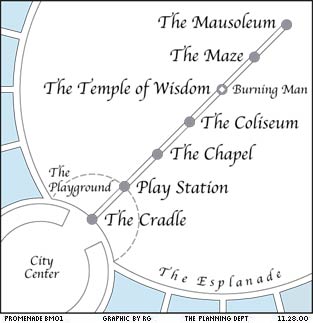
Architectural Plans and Rendering by Rod Garret
THE CRADLE
FIRST THINGS [ The Infant ]
 First among our stations is the Cradle. Here participants will assume the character of the Infant. In order to fulfill this role, it must be understood that babies are not blobs that passively await the imprint of their maker. As any parent can reliably inform you, they are extremely enterprising beings. Their task in life is nothing less than the creation of the world. Cast in this role, inhabitants of the Cradle must learn certain first and fundamental lessons. They will discover the existence of an up and down, a side to side, a near and far, and a figure and field. Amid this blooming and buzzing confusion of shifting impressions, they will be challenged to choose a First Object in life. Two looming figures, a primal Mother and Father, will preside above the Cradle. As a final accomplishment, participants will be asked to clamber upward to a pedestal that supports these great totemic presences, assume an upright position, and utter a First Word (If you do not know — or care — what your first word in life actually was, you may invent one). Those who accomplish this feat will receive the mark of the Infant as their official birth certificate.
First among our stations is the Cradle. Here participants will assume the character of the Infant. In order to fulfill this role, it must be understood that babies are not blobs that passively await the imprint of their maker. As any parent can reliably inform you, they are extremely enterprising beings. Their task in life is nothing less than the creation of the world. Cast in this role, inhabitants of the Cradle must learn certain first and fundamental lessons. They will discover the existence of an up and down, a side to side, a near and far, and a figure and field. Amid this blooming and buzzing confusion of shifting impressions, they will be challenged to choose a First Object in life. Two looming figures, a primal Mother and Father, will preside above the Cradle. As a final accomplishment, participants will be asked to clamber upward to a pedestal that supports these great totemic presences, assume an upright position, and utter a First Word (If you do not know — or care — what your first word in life actually was, you may invent one). Those who accomplish this feat will receive the mark of the Infant as their official birth certificate.
THE PLAYGROUND
PURE PLAY [ The Child ]
 Surrounding the Cradle, participants will encounter an area known as the Playground. This stage of life will be devoted to the purest form of play: play without an object or an end, play that rejoices in itself and seeks no further. Within this region we will scatter art toys of every kind. We are also soliciting art works that evoke the unique perceptions and experiences of childhood. Causation is magical in the Playground. Objects and events loom vivid and larger than life. This is a place in which to house our first impressions of a greater world. By visiting a central Play Station, participants can stamp their passports with the mark of the Child. Here also, participants may install some toy they wish to share from their own childhood.
Surrounding the Cradle, participants will encounter an area known as the Playground. This stage of life will be devoted to the purest form of play: play without an object or an end, play that rejoices in itself and seeks no further. Within this region we will scatter art toys of every kind. We are also soliciting art works that evoke the unique perceptions and experiences of childhood. Causation is magical in the Playground. Objects and events loom vivid and larger than life. This is a place in which to house our first impressions of a greater world. By visiting a central Play Station, participants can stamp their passports with the mark of the Child. Here also, participants may install some toy they wish to share from their own childhood.
THE CHAPEL
COMMITMENT [ The Lover ]
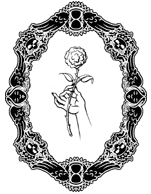 The symbol of the Chapel is the Lover. The underlying theme of this stage of life concerns our need to recognize the reality of others. Participants will be asked to select partners with whom they are willing to share vows and exchange gifts. These vows need not be solemn and may involve any form of reciprocation. However, the gift you offer should be real in some way tangible and heartfelt — and the oath you utter must actually oblige you to honor and fulfill a wish expressed by your partner. Both couples and groups may participate in these “marriage” ceremonies. When this ritual is completed, participants will be eligible to receive a wedding certificate, the mark of the Lover, as proof of their experience. “Quickie” wedding chapels, a hallowed tradition in the State of Nevada, may also be established as theme camps in Black Rock City and authorized to approve these unions. Wedding apparel of any kind will always be welcome in the Chapel, and a special wedding fashion show will be performed here during the event. Every year, also, a certain number of couples actually choose to be married at Burning Man, and we encourage them to consider the Chapel as a site for such ceremonies.
The symbol of the Chapel is the Lover. The underlying theme of this stage of life concerns our need to recognize the reality of others. Participants will be asked to select partners with whom they are willing to share vows and exchange gifts. These vows need not be solemn and may involve any form of reciprocation. However, the gift you offer should be real in some way tangible and heartfelt — and the oath you utter must actually oblige you to honor and fulfill a wish expressed by your partner. Both couples and groups may participate in these “marriage” ceremonies. When this ritual is completed, participants will be eligible to receive a wedding certificate, the mark of the Lover, as proof of their experience. “Quickie” wedding chapels, a hallowed tradition in the State of Nevada, may also be established as theme camps in Black Rock City and authorized to approve these unions. Wedding apparel of any kind will always be welcome in the Chapel, and a special wedding fashion show will be performed here during the event. Every year, also, a certain number of couples actually choose to be married at Burning Man, and we encourage them to consider the Chapel as a site for such ceremonies.
THE COLISEUM
STRUGGLE [ The Soldier ]
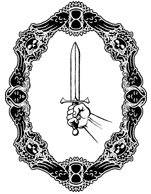 In contrast to the realm of pure play, the Coliseum will be an arena of competitive play. It is presided over by the figure of the Soldier. This stage relates to that period of life when we must measure our abilities against others in a public arena. In form, it will resemble a great coliseum surrounded by heroic artworks that celebrate the perennial human urge strive, to achieve and to prove ourselves. We invite participants to organize contests and games that can be staged here.
In contrast to the realm of pure play, the Coliseum will be an arena of competitive play. It is presided over by the figure of the Soldier. This stage relates to that period of life when we must measure our abilities against others in a public arena. In form, it will resemble a great coliseum surrounded by heroic artworks that celebrate the perennial human urge strive, to achieve and to prove ourselves. We invite participants to organize contests and games that can be staged here.
The Coliseum will also be the site of the 1st Annual Alternative Olympic Games. This event will invert the normal rules of athletic competition. Participants will be invited to invent their own sport. Anyone sustaining a certain number of challenges will become a World Champion. The essential premise of this competition is very simple. Given the diversity of our genetic make up and the essentially infinite number of actions of which each of us is capable, it stands to reason that every one is potentially the world champion of something. However, sport, as it is conventionally constituted, affords a very limited array actions whose mastery is deemed worthy of reward. To many, this seems grossly unfair. Why should glory be allotted to the winner of the hop, skip and jump, when the hop, fart, hiccup, wink and shuffle may present an equal or an even greater challenge? Why should ballroom dancing and water ballet be Olympic events, while wagging your ears as you balance an eel on the end of your nose is not? In 2001, our Alternative Olympic Games will allow participants an opportunity that’s not afforded by the elitist standards of normal sporting events. You will be empowered to create a unique activity that expresses your innate abilities. What do you really believe, in your heart of hearts, you can do better than anyone else? How can you really know until you test yourself? Unlike conventional athletic events, which dictate a winner and loser, our contest will also allow athletes to continuously modify the form or the rules of their sport. Should you be defeated in your chosen event, it is permissible to reinvent it. Participants who sustain challenges will be awarded the mark of the Soldier. Groups that engage in any form of contest or athletic competition at the Coliseum may also have these results so certified by Olympic officials.
THE TEMPLE OF WISDOM
ENLIGHTENMENT [ Burning Man ]
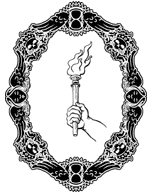 The Burning Man is a symbol of our shared humanity and equally represents men and women. Standing near the mid-point of this life course, he forms a moral nexus, a crossroads, a central intersecting point that unites our life’s decisions. This year we plan to redesign the platform that supports Burning Man. Mounted atop this platform and the central pylon that forms the tower of the Temple of Wisdom, the Man will rise 70 feet in the air. As in past years, every participant will have access to the deck that forms the base of this platform. However, access to the interior of the tower will only be granted to those who furnish proof that they have passed (in any order) through the six previous Ages of Man. Within the hidden depths of this looming edifice, they will undergo a final initiation that allows them to travel upward through the tower of the Temple to a chamber immediately beneath Burning Man. Here they will enjoy a view commanding the entire span of Black Rock City. From this four-story vantage they will also overlook the mile-long course of a lifetime laid out before them on the Promenade.
The Burning Man is a symbol of our shared humanity and equally represents men and women. Standing near the mid-point of this life course, he forms a moral nexus, a crossroads, a central intersecting point that unites our life’s decisions. This year we plan to redesign the platform that supports Burning Man. Mounted atop this platform and the central pylon that forms the tower of the Temple of Wisdom, the Man will rise 70 feet in the air. As in past years, every participant will have access to the deck that forms the base of this platform. However, access to the interior of the tower will only be granted to those who furnish proof that they have passed (in any order) through the six previous Ages of Man. Within the hidden depths of this looming edifice, they will undergo a final initiation that allows them to travel upward through the tower of the Temple to a chamber immediately beneath Burning Man. Here they will enjoy a view commanding the entire span of Black Rock City. From this four-story vantage they will also overlook the mile-long course of a lifetime laid out before them on the Promenade.
THE MAZE
REFLECTION & DECISION [ The Justice ]
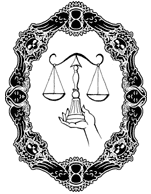 The era of a lifetime represented by the Maze lies somewhere in the area of middle age. It is intended to evoke that season of experience in which we reflect upon the consequence of our decisions. The Maze will be a place of genuine puzzlement. You may find it necessary to retrace your path from time to time, or carefully measure your footsteps as you progress through its corridors. At every turning you will confront a set of new and perplexing choices. Modeled on a work from former years, this large-scale complex of passageways, convoluted turnings and seemingly endless cul-de-sacs will lure participants into a world that appears to forever turn in on itself. As in real life, there are many methods you may use to find your way within the Maze. You might invent a system or develop a map. You might share information or trust to the advice of others or, as often happens in this life, you might just decide to rely on serendipity (dumb luck). The Maze will be an art gallery, affording artists who do wall-hung art or small sculptures the rare opportunity to exhibit their work in the wall-less world of Burning Man. We are seeking works that portray or suggest the many snares, illusions and temptations that may lead us astray as we follow life’s path. Your goal, and the solution of the problem posed by this puzzle, is to ascend to a high pavilion located somewhere near the center of the Maze. From here it will be possible to look down upon the plan of this complex, observe its twisting courses as a whole, and give encouragement and advice (perhaps, even misinformation) to those who toil below. Here, also, a magistrate, the Justice, will officially certify your completion of this life phase.
The era of a lifetime represented by the Maze lies somewhere in the area of middle age. It is intended to evoke that season of experience in which we reflect upon the consequence of our decisions. The Maze will be a place of genuine puzzlement. You may find it necessary to retrace your path from time to time, or carefully measure your footsteps as you progress through its corridors. At every turning you will confront a set of new and perplexing choices. Modeled on a work from former years, this large-scale complex of passageways, convoluted turnings and seemingly endless cul-de-sacs will lure participants into a world that appears to forever turn in on itself. As in real life, there are many methods you may use to find your way within the Maze. You might invent a system or develop a map. You might share information or trust to the advice of others or, as often happens in this life, you might just decide to rely on serendipity (dumb luck). The Maze will be an art gallery, affording artists who do wall-hung art or small sculptures the rare opportunity to exhibit their work in the wall-less world of Burning Man. We are seeking works that portray or suggest the many snares, illusions and temptations that may lead us astray as we follow life’s path. Your goal, and the solution of the problem posed by this puzzle, is to ascend to a high pavilion located somewhere near the center of the Maze. From here it will be possible to look down upon the plan of this complex, observe its twisting courses as a whole, and give encouragement and advice (perhaps, even misinformation) to those who toil below. Here, also, a magistrate, the Justice, will officially certify your completion of this life phase.
THE MAUSOLEUM
REMEMBRANCE [ The Pantaloon ]
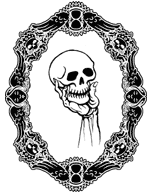 The Mausoleum forms a great repository; a solemn monument designed to house our memories of lives we’ve admired. It will be located at the end point of the Promenade that forms the central axis of our life span. Itself a large-scale funerary monument, it will also serve as both an archive and registry of past lives. Here participants will honor the careers of those who’ve gone before themà family members, friends, mentors, lovers, or actors upon the great stage of the world. These must be people who have actually influenced how you lead your life and whose example, admired and emulated, has guided your conduct. Our tribute to these heroes will be twofold. Participants must select or create some token or artifact that represents the life they have decided to honor. These will be stored in the Mausoleum’s archive. Participants will also be asked to write a brief account explaining the personal significance of these items. These offerings and their accompanying texts will be cross-indexed, allowing other participants to examine the entire collection of relics (We also plan to publish a selection of these texts on our website after the event). Only when these things have been produced will you receive the stamp, as a memento mori, of the aged Pantaloon. Near the end of the Burning Man event, all of these accumulated memories will be cremated on an ornate funeral pyre. Ceremonies you devise to honor the deceased may also be enacted here.
The Mausoleum forms a great repository; a solemn monument designed to house our memories of lives we’ve admired. It will be located at the end point of the Promenade that forms the central axis of our life span. Itself a large-scale funerary monument, it will also serve as both an archive and registry of past lives. Here participants will honor the careers of those who’ve gone before themà family members, friends, mentors, lovers, or actors upon the great stage of the world. These must be people who have actually influenced how you lead your life and whose example, admired and emulated, has guided your conduct. Our tribute to these heroes will be twofold. Participants must select or create some token or artifact that represents the life they have decided to honor. These will be stored in the Mausoleum’s archive. Participants will also be asked to write a brief account explaining the personal significance of these items. These offerings and their accompanying texts will be cross-indexed, allowing other participants to examine the entire collection of relics (We also plan to publish a selection of these texts on our website after the event). Only when these things have been produced will you receive the stamp, as a memento mori, of the aged Pantaloon. Near the end of the Burning Man event, all of these accumulated memories will be cremated on an ornate funeral pyre. Ceremonies you devise to honor the deceased may also be enacted here.
Seven Ages symbols by David Normal.
Shakespeare & The Seven Ages
The title of our art theme and many of its symbols are taken from a famous speech in Shakespeare’s ‘As You Like It’. It is delivered by Jaques, a melancholic philosopher. These lines are notable amid the canon of a writer unparalleled in the power of his negative imagery. Life, as imaged here, is a dark and unredeemable tale of folly, loss and dissolution. Our own Seven Ages of Man is very much the opposite of Shakespeare’s vision. We don’t presume to improve on the Bard. Life can be nasty and depressing, as is amply demonstrated by this exquisite poetry. Nor do we wish to discourage participating artists from illustrating such bitter truths in their work. We do mean to suggest, however, that the meaning of one’s life is an immediate result of one’s actions. The following passage is quoted from Act II, Scene VII.
“All the world’s a stage,
And all the men and women merely players.
They have their exits and the entrances.
And one man in his time plays many parts,
His acts being seven ages. At first the infant,
Mewling and puking in the nurse’s arms.
Then the whining schoolboy, with his satchel
And shining morning face, creeping like snail
Unwillingly to school. And then the lover,
Sighing like furnace, with woeful ballad
Made to his mistress’ eyebrow. Then a soldier,
Full of strange oaths and bearded like the pard*,
Jealous in honor, sudden and quick in quarrel,
Seeking the bubble reputation
Even in the canon’s mouth. And then the justice,
In fair round belly with good capon lined,
With eyes severe and beard of formal cut,
Full of wise saws and modern instances,
And so he plays his part. The sixth age shifts
Into the lean and slippered pantaloon*
With spectacles on nose and pouch on side,
His youthful hose, well saved, a world too wide
For his shrunk shank, and his big manly voice,
Turning again toward childish treble, pipes
And whistles in his sound. Last scene of all,
That ends this strange eventful history,
Is second childishness and mere oblivion,
Sans teeth, sans eyes, sans taste, sans everything.”
* pard: leopard
* pantaloon : The decrepit old man of Italian commedia dell’arte

